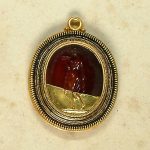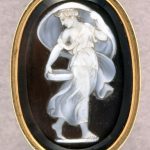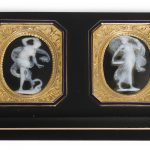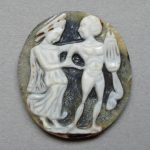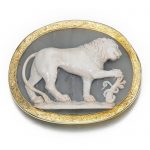Information on Tuccia and her depiction in cameos. Tuccia was one of the priestesses of Vesta, the goddess of the hearth in ancient Rome. In order to best perform their task – the maintenance of the Vesta’s sacred fire, which was of the highest importance for the security of Rome – the Vestal Virgins had to take a vow of chastity and so were freed from social obligations such as marriage and maternity. In the 18th and 19th centuries, Vestals became a symbol for Republican virtue, evoked by the discovery of the Temple of Vesta in Rome and the rediscovery of Pompeii in 1748.
When her chastity was questioned, she had to prove her innocence by carrying a sieve filled with water without it leaking. Subjects from Antiquity, as well as motifs from Greek mythology such as Eurydice and the serpent, inspired stone cutters and gem engravers, such as the Pichler family. The half-brothers Luigi and Giovanni Pichler, born in Italy to the Tyrolean goldsmith Anton Pichler, both studied under Neoclassical artists and soon became the most sought-after engravers of the 18th century, particularly because of the sharpness and clarity of their cameos and intaglios of highest quality. The Pichlers received commissions from all over the world, among them one from Empress Josephine for a cameo of the Pope Pius VII, which she gave to Napeoleon I. Reference: Sotheby’s
By the late Middle Ages, the image of Tuccia and her sieve became associated with the virtue of chastity. Paintings of chaste women would often include a sieve and this symbol figures prominently in many depictions of England’s “Virgin Queen” Elizabeth I in the late sixteenth century. Reference: Wikipedia
An 18th century hardstone and gold intaglio pendant, last third of the eighteen century The central agate seal carved to depict the Vestal Virgin Tuccia, unjustly accused of unchastity, she proved her innocence by carrying water from the river Tiber in a sieve, set within an elaborate layered ropewtist border, length 3.8cm.
The image used in this piece was popular in neo-classical gem engraving, perhaps because of the opportunity it afforded of depicting a graceful female in motion; both Giovanni and Luigi Pichler included Tuccia figures among their gems. The technique of completing fragmentary stone with an engraving in gold was employed by eighteenth century artists, as here, to give the impression of preserving an important ancient stone. Both the very regular diagonal cut and the elaborate gold mounting as a pendant support the suggestion that this gem was created as a pseudo-Roman gem and accepted as such by its eventual owner.
Sold for £456 inc. premium at Bonhams in 2005
18th century Cameo; onyx; Tuccia, the Vestal Virgin, advancing to right, looking back over her shoulder; raised left hand holds fold of drapery which blows behind her head; in right hand is the sieve in which she carried water to prove her chastity; in modern gold ring.
Reference: © The Trustees of the British Museum
A gold-mounted tortoiseshell and cameo snuffbox, Pierre-André Montauban, Paris, 1798-1809 rectangular, the lid inset with two oval onyx cameos, one carved with Eurydice in swirling garments bitten by the serpent, after Giovanni Pichler, the other with the vestal virgin Tuccia with her sieve, after Luigi Pichler, each in a rectangular gold spandrel with cut corners, chased with leaf motifs, within dark blue enamel borders, gold mounts and lining, maker’s mark, bear’s head 3e titre and 3e Paris titre et garantie 1798-1809 8.9cm., 3 1/2 in. long
Sold for 10,000 GBP at Sothebys in 2018
